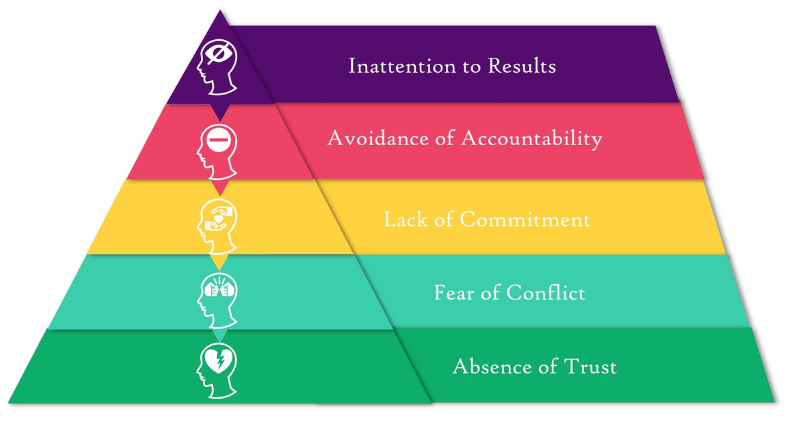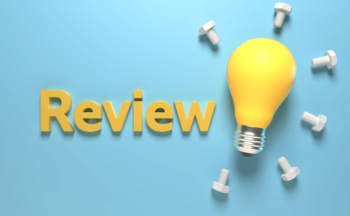In any organization, teamwork isn’t just a nice-to-have—it’s the engine that drives results. But what happens when the engine is out of tune? That’s the question best-selling author Patrick Lencioni sought to answer in his book The Five Dysfunctions of a Team. And it’s the very topic I recently explored with leadership coach Judith-Rose Max (JR) from Mirato Coaching, who helps managers build high-performing teams by understanding the behavioral styles and emotional dynamics that shape team culture.
JR and I dove deep into not just what the dysfunctions are, but how to fix them with intentional leadership and systems that create a foundation for trust, alignment, and success.
The Pyramid of Dysfunction: A Quick Recap
Lencioni presents the five dysfunctions in the form of a pyramid, where each dysfunction builds upon the next:

Let’s explore how each dysfunction manifests—and the systems you can implement to overcome them.
1. Absence of Trust
The Problem: Teams that lack trust don’t feel safe being vulnerable with one another. They hide weaknesses, avoid asking for help, and struggle to collaborate openly. As JR puts it, “Trust is the foundation of every high-functioning team. Without it, people go through the motions but never truly engage.”
The Solution: Create psychological safety.
Systems That Help:
-
Behavioral style profiling tools (like DISC or MBTI) to build mutual understanding.
-
Team retrospectives and personal check-ins—structured time to talk about personal wins, fears, and growth areas.
-
Leadership modeling of vulnerability: admitting mistakes, asking for feedback, and inviting collaboration.
-
Way We Do’s Workflows for team onboarding that explain roles clearly, build consistency, and reduce ambiguity—a major trust killer.
2. Fear of Conflict
The Problem: Without trust, team members are reluctant to speak up. Conflict gets buried under passive-aggressiveness or post-meeting grumbles at the proverbial water cooler.
As JR shared, “Healthy conflict is essential. If people don’t feel safe to disagree openly in the meeting, they’ll do it after the meeting—and that’s where momentum dies.”
The Solution: Encourage constructive, idea-based debate.
Systems That Help:
-
Structured meeting agendas with decision-making frameworks (like RACI or DACI).
-
Team norms or “Rules of Engagement” documented in your team manual or SOPs, including how to disagree respectfully.
-
Anonymous input tools for raising sensitive concerns.
-
Debrief Process that allow for reflection and discussion after major decisions or projects—so feedback isn’t just one-off but embedded into your workflow.
3. Lack of Commitment
The Problem: Without healthy conflict, people don’t buy in. They nod along in meetings but lack genuine engagement. This leads to ambiguity, misalignment, and half-hearted execution.
As JR pointed out, “Commitment doesn’t mean unanimous agreement. It means everyone’s voice was heard, and we’re united in moving forward.”
The Solution: Align around shared goals and processes.
Systems That Help:
-
Visible, team-wide goal tracking systems (e.g., OKRs or KPIs linked to workflows).
-
Project charters and process guides to document and socialize major initiatives.
-
Workflows with defined decision gates to ensure alignment at key points.
-
Digital collaboration spaces like Way We Do that centralize updates and feedback.
4. Avoidance of Accountability
The Problem: If no one truly committed, then no one feels responsible for holding others accountable. Performance drops. Standards slip. The culture becomes one of “good enough.”
“Accountability is only possible when there’s clarity on who’s doing what—and trust that feedback is about growth, not punishment,” JR noted.
The Solution: Build a culture of ownership and feedback.
Systems That Help:
-
Clear role assignments within workflows. In Way We Do, tasks are assigned by role, not person, so accountability isn’t personality-dependent.
-
Performance dashboards that make progress and delays transparent.
-
Regular 1-on-1s and team health checks—opportunities to praise, course-correct, and reset expectations.
-
After-action review templates to learn from what worked and what didn’t, without finger-pointing.
5. Inattention to Results
The Problem: When team members care more about personal success—status, recognition, or safety—than team success, results suffer. Politics creeps in. Innovation stalls.
“We see this all the time,” said JR. “People stay in their lane, protect their patch, and forget the shared goal. The antidote? Focus on legacy. Help people see the bigger picture.”
The Solution: Make success about collective outcomes, not individual wins.
Systems That Help:
-
Company-wide scoreboards that show progress toward shared goals.
-
Recognition systems that reward collaboration and team results—not just individual achievements.
-
Cross-functional projects that require departments to work together toward outcomes.
-
Leadership vision documents and videos to remind teams of the “why”—the future they’re helping to build.
Turning Dysfunction Into Function: A Leadership Imperative
As JR said powerfully, “Every dysfunction has an antidote. And with the right mindset and systems, you can move from dysfunction to high performance.”
Here’s how to map the dysfunctions to the systems needed:
| Dysfunction | Antidote | Supporting Systems & Tools |
|---|---|---|
| Absence of Trust | Vulnerability-based trust | Behavioral profiling, team check-ins, transparent onboarding |
| Fear of Conflict | Healthy debate | Meeting frameworks, conflict norms, debriefs |
| Lack of Commitment | Clarity and buy-in | Documented goals, charters, role-based workflow ownership |
| Avoidance of Accountability | Peer and leadership accountability | Dashboards, 1-2-1s, SOP-linked performance checks |
| Inattention to Results | Focus on collective outcomes | Shared metrics, cross-team initiatives, legacy visioning |
Final Thoughts: Systems Are Cultural Anchors
Too often, companies think of systems as bureaucratic. But when used intentionally, systems are not red tape—they are cultural anchors. They give teams clarity, build habits, and allow humans to show up as their best selves, even on hard days.
At Way We Do, we help businesses implement these systems into daily workflows. When SOPs, policies, training, and processes are more than documents—when they’re lived and breathed daily—teams can overcome dysfunction and achieve extraordinary results.
And sometimes, as JR reminded us, you don’t have to do it alone. Bringing in a leadership coach or systems specialist can be the catalyst for transformation.
“We can only see and do what we’ve done before. We need someone to help us step out of our comfort zone and expand.”
Well said, JR.
Want help implementing systems to overcome team dysfunction?
Reach out to JR from Mirato Coaching on LinkedIn. And if you’re ready to embed high-performance practices into your business, Way We Do is also here to help. Let’s build the systems that make your culture thrive.





